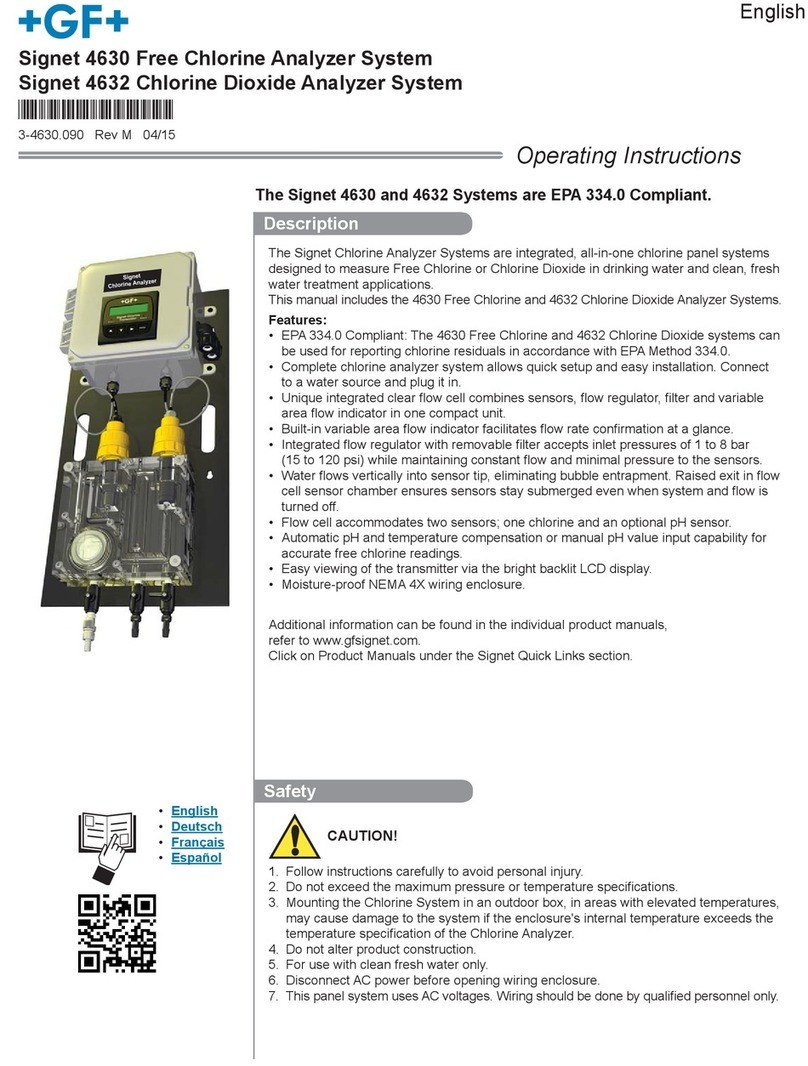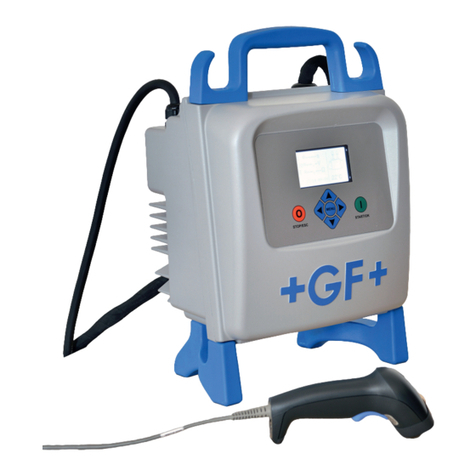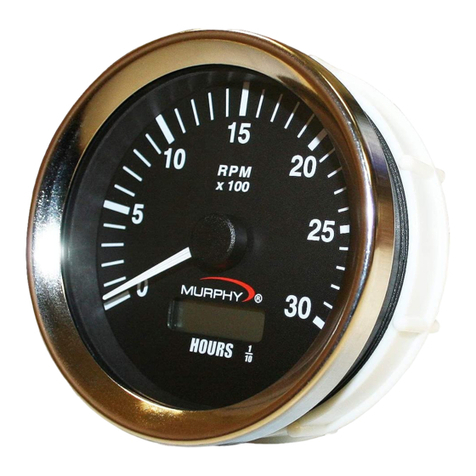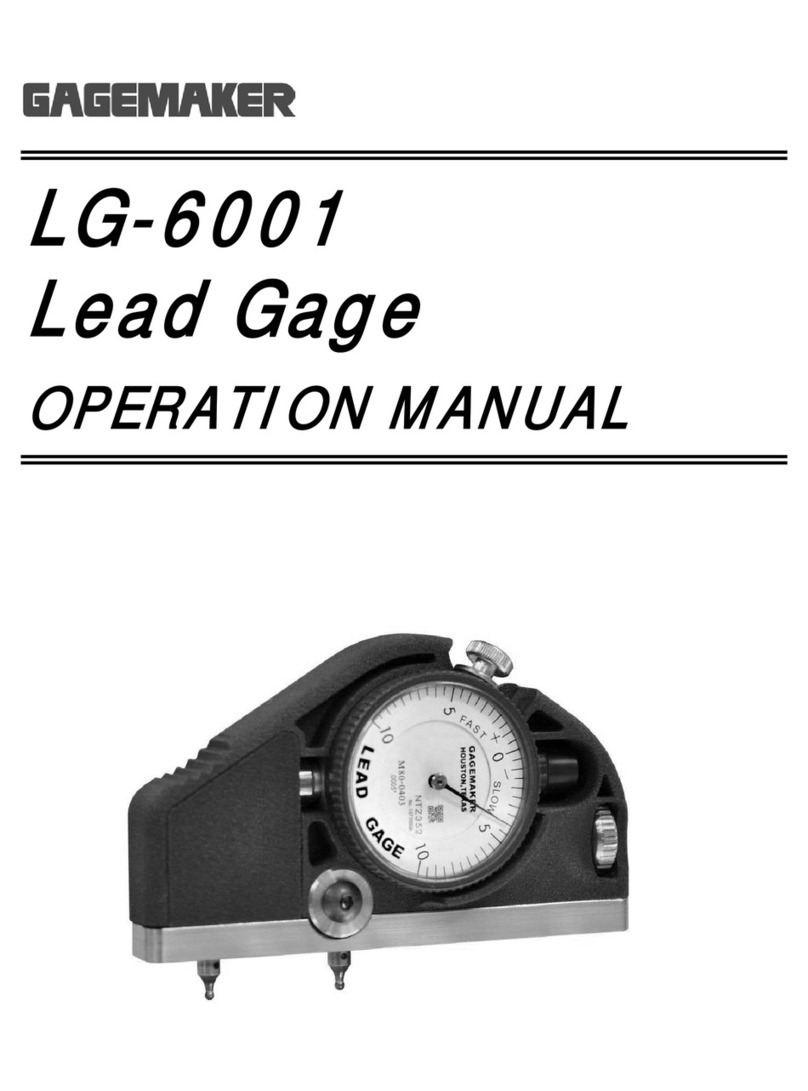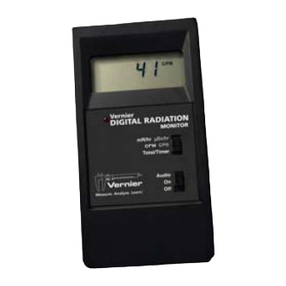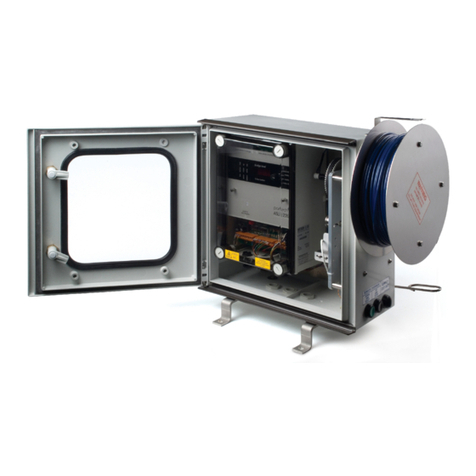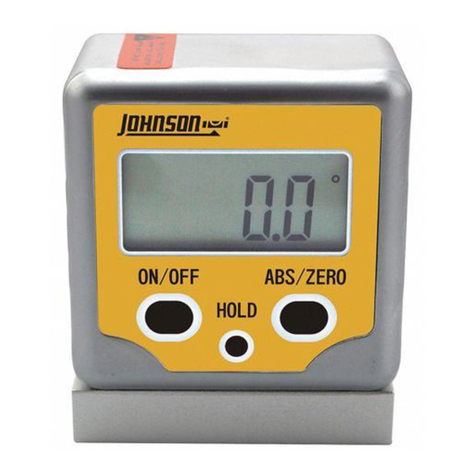GF Signet 8850-3 User manual

The Signet 3719 pH/ORP Wet-Tap allows installation and removal of pH or
ORP electrodes without the need for process shutdown during routine electrode
maintenance and calibration. Process isolation is achieved with a double O-ring
seal on a unique and compact retraction assembly; no separate valve is required.
A cam-activated automatic locking mechanism, SafeLoc™, and the short stroke
design help to assure operator safety.
English
WARNING!
If used in conditions that exceed recommended
pressure ratings, this product can pose a serious
hazard.
We urge customers to read the specifications
carefully before installing and operating this product.
Improper use can cause components and process
liquids to be expelled at high speeds and cause
serious personal injury.
*3-3719.090*
3-3719.090 Rev. P 06/17
Signet 3719 pH/ORP Wet-Tap
Description
Table of Contents
Operating Instructions
• English
• Deutsch
• Français
• Español
Warranty Information ......................................................... 2
Product Registration.......................................................... 2
Safety Information ............................................................. 2
Dimensions........................................................................ 2
Specifications .................................................................... 3
System Overview............................................................... 3
Installation ......................................................................3-5
Location, Orientation and Required Clearance ............3-4
For pipe sizes 2.5 to 12 in. .......................................... 4
For pipe sizes less than 2.5 in..................................... 4
Wet-Tap into Fitting...................................................... 5
Electrode Installation ................................................... 5
Electrode Removal ............................................................ 6
Electrode Maintenance...................................................... 6
Troubleshooting................................................................. 7
Ordering Information.......................................................... 8

2 Signet 3719 pH/ORP Wet-Tap
76 mm
(3.0 in.)
130 mm
(5.13 in.)
49 mm
(1.94 in.)
45 mm
(1.75 in.)
39 mm
(1.52 in.)
20 mm
(0.8 in.)
75 mm
(2.94 in.)
Pipe thread
1
1
/
2
in. NPT
or
ISO 7-R1
1
/
2
76 mm
(3.0 in.)
39 mm
(1.52 in.)
20 mm
(0.8 in.)
Pipe thread
2 in. NPT
or
ISO 7-R2
34 mm
(1.32 i
41 mm
(1.62 in.
25 mm
(1.00 in.)
3719-1 Wet-tap
11/2 in. outlet for 21/2 to 4 in. pipe
3719-2 Wet-tap
2 in. outlet for 6 to 12 in. pipe
CAUTION!
When using clamp-on saddle fittings (customer-supplied),
the system temperature and pressure is limited by the saddle
specifications.
The process temperature is limited to 40 °C (104 °F) maximum
when using saddles.
218 mm
(8.57 in.)
35 mm
(1.4 in.)
2756-WT(-1) pH electrode, glass
2756-WTP(-1) pH electrode, plastic
2757-WT ORP electrode, glass
2757-WTP ORP electrode, plastic
Refer to your local Georg Fischer Sales office for the most
current warranty statement.
All warranty and non-warranty repairs being returned must
include a fully completed Service Form and goods must be
returned to your local GF Sales office or distributor.
Product returned without a Service Form may not be
warranty replaced or repaired.
Signet products with limited shelf-life (e.g. pH, ORP, chlorine
electrodes, calibration solutions; e.g. pH buffers, turbidity
standards or other solutions) are warranted out of box but not
warranted against any damage, due to process or application
failures (e.g. high temperature,
chemical poisoning, dry-out) or
mishandling (e.g. broken glass,
damaged membrane, freezing
and/or extreme temperatures).
Thank you for purchasing the Signet line of Georg Fischer
measurement products.
If you would like to register your product(s), you can now
register online in one of the following ways:
• Visit our website www.gfsignet.com.
Under Service and Support click on
Product Registration Form
• If this is a pdf manual (digital copy), click here
Warranty Information
Product Registration
Safety Information
Caution / Warning / Danger
Indicates a potential hazard. Failure to follow all warnings
may lead to equipment damage, injury, or death
Personal Protective Equipment (PPE)
Always utilize the most appropriate PPE during
installation and service of Signet products.
Pressurized System Warning
Sensor may be under pressure, take caution to vent
system prior to installation or removal. Failure to do so
may result in equipment damage and/or serious injury.
Dimensions
• Do not exceed maximum temperature/pressure
specifications.
• Wear safety goggles or face shield during
installation/service.
• Do not attempt to disassemble the retraction housing
and the electrode piston.
• Do not alter product construction.
• Failure to follow safety instructions may result in severe
personal injury.
• Retract electrode before any pipe cleaning operation.

3Signet 3719 pH/ORP Wet-Tap
Notes on Location, Orientation and Required Clearance
• The 3719-1 is designed for use in pipes up to 4 in.
• The 3719-2 is designed for use in pipes from 6 to 12 in.
• Select a location that will provide sufficient clearance to
remove and insert the electrode.
• The 3719 can be mounted in any orientation, including
horizontal and inverted. Avoid the 12 o'clock position. In the
presence of sediment, avoid the 6 o'clock position.
• If inverted, use caution when removing the sensor.
Residual fluid may be
present in the retraction
housing. Keep electrode
connector clean and dry at
all times.
Any angle OK
a
b
c
d
e
d
a) 3719 pH/ORP Wet-Tap
b) Customer-supplied Low-Profile Clamp-on Saddle Fitting
(ASTM sizes 2½ to 12 in.)
c) DryLoc®pH or ORP Electrode (6 versions available; see
ordering infomation on page 8.)
(DryLoc®refers to the electrode connector style)
d) 2750 or 2760 DryLoc®pH/ORP Preamplifier/Sensor
electronics
e) Output signal options:
2750:
- Digital (S3L)
- 4 to 20 mA
2760:
- Analog mV Output- Digital (S3L)
All components (items a–d) are sold separately.
General
Compatible sensors:
2756-WT DryLoc®pH Electrode
2756-WT-1 DryLoc pH Electrode
2756 -WTP DryLoc plastic pH electrode
2756-WTP-1 DryLoc plastic pH electrode
2757-WT DryLoc ORP Electrode
2757-WTP DryLoc plastic ORP electrode
Shipping Weight
Wet-tap assembly ............. 1.2 kg (2.7 lbs.)
Electrode........................... 0.13 kg (0.3 lb)
Process Connection ............. 3-3719-11: 1½ in. NPT
3-3719-21: 2 in. NPT
3-3719-12: ISO 7/1-R1½
3-3719-22: ISO 7/1-R2
Wetted materials
Retraction Housing............... CPVC
O-rings.................................. FKM
Electrode Body ..................... Glass or Plastic
Electrode junctions ............... Porous PTFE
Electrode sensing surface .... Glass Membrane (pH)
Platinum (ORP)
Electrode O-rings.................. FKM
Other Materials
Locking Shroud..................... PVC
Hardware.............................. 316 stainless steel
Performance
Maximum Flow Velocity ........ 3 m/s (10 ft/s)
Response Time
pH ..................................... <5s for 95% of signal change
ORP .................................. Application dependent
Drift....................................... < 2 mV per week
Operating Range
pH ..................................... 0 to 14 pH
ORP .................................. –2000 to +2000 mV
Reference Junctions............. Porous PTFE
Electrolyte............................. 3.5M KCl
Elements............................... Ag/AgCl
Temp. Sensor (pH) ............... 3K Balco (3-2756-WT-1, WTP-1)
PT1000 (3-2756-WT, -WTP)
Temp. response time (τ) ....... 438 s
Sodium Ion Error .................. < 0.05 pH in 0.1 molar
Na+ ion at 12.8 pH
Impedance (pH).................... <150 MΩ@ 25 °C
Storage Temperature
Wet-tap assembly ............. -15 to 120 °C (5 to 248 °F)
Electrode........................... 0 to 50 °C (32 to 122 °F)
Standards and Approvals
Manufactured under ISO 9001 and 14001
China RoHS (Go to www.gfsignet.com for details)
25
Specifications System Overview
Installation

4 Signet 3719 pH/ORP Wet-Tap
Installation in Pipe Sizes 2.5 to 12 Inches
• For reliable in-line measurements of pH and ORP, it is
imperative to position the electrode tip into the process
stream.
• Because of its compact “short stroke” design, the 3719
requires low-profile fittings to ensure
proper positioning in pipe sizes
DN65 to DN300 (2.5 to 12 inches).
• It is strongly recommended to
use low-profile PP clamp-on
saddle fittings (customer-
supplied).
• Choose the 3719 version (-11
or -21) appropriate to the size
of the branch connection of the
required fitting:
Use -11 for sizes DN65 to DN100
(2.5 to 4 in), and -21 for sizes
DN150 to DN300 (6 to 12 in.)
Installation in Pipe Sizes less than 2.5 Inches
• It is possible to install the 3719 into pipe sizes below
2.5 inches by creating a “flow cell” with standard piping
components.
• One simple solution, using a tee fitting and reducer bushings,
is shown in the example below.
• Many similar configurations are conceivable in a wide
variety of materials, but be very careful to verify dimensional
compatibility.
• Select an appropriate installation orientation to avoid the
entrapment of air inside the flow cell.
• Contact your local Georg Fischer Sales and Support office
for assistance.
3-3719-11
pH/ORP Wet-Tap
(Fully Inserted)
2 in. Tee
(S x S x S)
1½ in. NPT
Threads
Flush Style Reducer
Bushings (Spg x S)
2 in. x ½ in.
2 in. x ¾ in.
2 in. x 1 in.
2 in. x 1¼ in.
2 in. x 1½ in.
3-3719-11
pH/ORP Wet-Tap
Flush Style Reducer Bushing
(Spg x FT) 2 in. x 1½ in.
250 mm
(9.9 in.)
45 mm
(1.75 in.)
115 mm
(4.5 in.)
218 mm
(8.57 in.)
OR
89.4 mm
(3.5 in.)
• Provide 20 inches (minimum) clearance from the top of the
pipe for electrode removal..
Installation continued Installation continued

5Signet 3719 pH/ORP Wet-Tap
Pull the locking
shroud straight
up until both
O-rings are fully
seated inside
the retraction
housing.
Grasp the retraction
housing below the
locking shroud; turn the
locking shroud 1/4-turn
clockwise.
12
The 3719 is packaged with no electrode installed, and with the electrode piston in the fully inserted position.
• Examine the female threads at the top of the electrode piston. Do not install electrode if threads are damaged.
• Examine the two O-rings at the lower end of the assembly. Do not install if O-rings are missing or there are any signs
of damage.
• Lubricate O-rings with a non-petroleum based, viscous lubricant (grease) compatible with the system.
• The pipe can be pressurized after completion of step 4.
• DO NOT ATTEMPT TO REMOVE THE RETRACTION HOUSING FROM A PRESSURIZED PIPING SYSTEM!
Installation (Wet-Tap Into Fitting)
Lubricated
O-rings
Locking
Shroud
Retraction
Housing
Turn the
shroud 1/4-turn
counterclockwise
and lift it
completely away
from the electrode
piston.
• Thread the Wet-Tap into the
pipe fitting.
• Smaller pipes may require
bracing to support the Wet-Tap
weight and the longitudinal
forces required for operation.
• Use an appropriate thread
sealant to prevent leaks.
• The piping system can now be
safely pressurized.
• Inspect the installation for leaks.
34
The electrode piston is locked
in position by SS locking pins.
DO NOT tamper with the
locking pins!
If the piston is depressed with
no electrode installed, the pipe
contents are exposed.
Electrode
Piston
Electrode Installation
Before installation, lubricate O-rings with a non-
petroleum based, viscous lubricant (grease)
compatible with the system.
1. Remove the safety plug from top of electrode
piston. Slide electrode straight down into
electrode piston. Thread electrode into place
until connector shoulder is flush with top of
electrode piston. Hand tighten only.
WARNING:
Do not flex the electrode when inserting
into the Wet-Tap assembly. The electrode can
be permanently damaged if it is flexed during
installation.
2. Place the Locking Shroud over electrode; turn
¼-turn clockwise to unlock the piston, then press
down firmly on the locking shroud to lower the
electrode piston into the pipe.
3. Turn the shroud 1/4-turn counterclockwise to lock
the piston.
4. Install the matching electronics assembly or
preamplifier onto the electrode connector.
DO NOT ATTEMPT TO
REMOVE THE RETRACTION
HOUSING FROM A
PRESSURIZED PIPING
SYSTEM!
Installation continued
1
2
34
OR
Lubricate O-Rings
Lubricate O-Rings
2750 2760

6 Signet 3719 pH/ORP Wet-Tap
The electrode in any pH or ORP system
requires periodic service, calibration or
replacement. When removing the electrode
from the wet-tap assembly, it is very important
to exercise caution and follow the instructions
carefully.
1. Remove the preamplifier from the top of
the wet-tap assembly.
2. Turn the locking shroud 1/4-turn clockwise
to unlock the piston.
3. Pull up on the locking shroud to retract the
electrode piston into the pipe.
If the piston does not retract easily, or if any fluid is observed leaking from the electrode
threads, the pipe must be drained before the 3719 can be safely removed.
• Stop the flow and depressurize the pipe.
• Remove the entire 3719 assembly from the pipe.
• Remove the electrode from the assembly
• Clean any scaling and debris found on or in the piston tip and surrounding area.
Cleaning
Cleaning techniques vary depending on the type of coating present on the glass electrode surface or reference junction.
• Remove soft coatings by vigorous stirring, or with directed spray of a suitable detergent or solvent onto the glass electrode surface.
• Use chlorine bleach or mild detergent to remove soft coatings. Rinse electrode tip in clean water after cleaning.
• Use the least harsh chemical available to remove hard coatings without attacking the materials of construction.
(For example, remove calcium carbonate with a 5% HCl (muriatic acid) solution.
• Remove oily or organic coatings with detergents or an appropriate solvent that does not attack the materials of construction.
• ORP electrode surface (platinum) can be gently sanded with 600 grit wet and dry silicone or carbide sandpaper, jewelers rouge,
crocus cloth, or very fine steel wool.
• Never scrape or sand the glass electrode surface.
• Treat glass electrode surfaces with appropriate care to avoid breakage.
• Lubricate O-rings with a non-petroleum based, viscous lubricant (grease) compatible with the system.
Wet-Tap Maintenance
• The Wet-Tap assembly should be operated (retracted) on a monthly basis
• The O-rings on the piston tip should be inspected and lubricated annually, and whenever the system is off line for maintenance.
• Lubricate O-rings with a non-petroleum based, viscous, lubricant (grease) compatible with the system.
23 4 5
1
5
3
4. Turn the locking shroud ¼-turn
counterclockwise and lift up to remove it from the wet-tap
assembly.
5. Remove the electrode by turning it counterclockwise.
For safety, keep your body clear of the top of the wet-tap
assembly while removing the electrode.
DANGER!
The piston should retract easily from a pressurized pipe.
If the piston offers resistance, there is a danger that the
piston is coated with deposits from the process.
STOP! DO NOT FORCE THE PISTON UP!
It may damage the O-rings or break off the piston tip.
Return the locking shroud to the LOCKED position and follow the
steps in the box below.
DANGER!
If any fluid is observed leaking from the electrode
threads, STOP! DO NOT REMOVE THE ELECTRODE.
There is a danger that the piston tip has been damaged.
Tighten the electrode back down to reseal the assembly
and follow the steps in the box below.
Electrode Removal
Electrode Maintenance

7Signet 3719 pH/ORP Wet-Tap
Offset in pH Electrodes
Electrode offsets occur due to:
• Clogged reference junction
• Aged or contaminated reference solution/wire
• A constant output near 0 mV in all buffer solutions indicates a shorted electrode
that must be replaced.
Check offsets in a pH 7 buffer @ 25 °C. The theoretical output is 0 mV. Any deviation from 0
mV is the pH electrode offset. The mV offset will track across the entire pH range. The slope
is usually not affected by offset changes.
(i.e., pH 7= +10 mV, pH 4= +187 mV); slope = 59 mV.
pH Electrode Offset pH 7 buffer @ 25 °C
Theoretical: pH 7.0 (0.0 mV)
New electrode: pH 7 ± 0.25 pH (±15 mV)
Reliable: pH 7 ± 0.85 pH (± 50 mV)
Electrode offsets greater than 0.85 pH (50 mV) indicate the electrode requires cleaning
or replacement. See Maintenance and Cleaning section.
Offset in ORP Electrodes
• ORP electrode offsets are usually caused by clogged reference junctions or by an aged or contaminated reference solution/wire.
• Offsets should be checked in pH 7 buffer saturated with quinhydrone @ 25 °C. The theoretical output is +86 mV.
Any deviation from +86 mV is the ORP electrode offset (e.g., +90 mV).
• Quinhydrone is the oxidizer measured by the ORP electrode and is required for calibration.
To measure ORP electrode offset, saturate 50 mL of pH 4 and pH 7 buffers with ⅛g quinhydrone.
A new ORP electrode measures these values ±15 mV. The electrode continues to be functional until the offset from these values
exceeds 50 mV. Electrodes with offset greater than 50 mV should be cleaned and replaced if necessary.
°C pH
23456789101112
15 0.15 0.12 0.09 0.06 0.03 0 0.03 0.06 0.09 0.12 0.15
2500000000000
35 0.15 0.12 0.09 0.06 0.03 0 0.03 0.06 0.09 0.12 0.15
45 0.3 0.24 0.18 0.12 0.06 0 0.06 0.12 0.18 0.24 0.3
55 0.45 0.36 0.27 0.18 0.09 0 0.09 0.18 0.27 0.36 0.45
4 pH w/Quinhydrone 7 pH w/Quinhydrone
Temp: 20 °C 25 °C 30 °C 20 °C 25 °C 30 °C
ORP: 268 mV 263 mV 258 mV 92 mV 86 mV 79 mV
Slope in ORP electrodes
ORP slope errors are caused by contamination of the platinum electrode surface. Cleaning the electrode surface will usually restore
proper values, response time, and stability. Many systems require both pH and ORP calibration. To conserve calibration reference
solutions, use pH 7 and 4 buffers for pH calibration first. ORP calibration can be performed with the same buffers after adding
quinhydrone.
Slope in pH electrodes
Electrode slope is the mV output per pH unit. At 25C the theoretical slope is 59.16 mV per pH. The graph below illustrates potential
pH error when a temperature-compensated instrument is not used.
• Coatings on the glass may affect sensor slopes. See Maintenance and Cleaning section.
• Temperature affects electrode slope. Calibrate temperature before calibrating the standard and slope.
Response Time/Stability
Response time and stability are affected by the condition of the glass surface (ORP electrode - Platinum surface), reference junction,
and reference solution. Restoration to acceptable levels can often be accomplished by cleaning the electrode's glass surface (ORP
electrode - platinum surface) and reference junction.
pH and ORP electrodes are similar to batteries; they age with time and usage.
The following information will help maximize electrode life:
• High temperatures or concentrated acids/caustics will accelerate electrode aging.
• Never store the electrode tip in deionized (DI) water.
• Never expose electrode to temperatures below –12 °C (10 °F) or allow it to dehydrate. These conditions will damage the electrode.
Troubleshooting
Theoretical mV Values @ 25 °C
pH mV
2 +296 mV
3 +237 mV
4 +177 mV
5 +118 mV
6 +59 mV
7 0 mV
8 -59 mV
9 -118 mV
10 -177 mV
11 -237 mV
12 -296 mV

Georg Fischer Signet LLC, 3401 Aerojet Avenue, El Monte, CA 91731-2882 U.S.A. • Tel. (626) 571-2770 • Fax (626) 573-2057
For Worldwide Sales and Service, visit our website: www.gfsignet.com • Or call (in the U.S.): (800) 854-4090
For the most up-to-date information, please refer to our website at www.gfsignet.com
3-3719.090 Rev P 06/17 English © Georg Fischer Signet LLC 2017
3-2756-WT Dry-Loc pH electrode
3-2756-WT-1 Dry-Loc pH electrode
3-2756-WTP Dry-Loc pH electrode
3-2756-WTP-1 Dry-Loc pH electrode
3-2757-WT Dry-Loc pH electrode
3-2757-WTP Dry-Loc ORP electrode
1220-0114
O-rings
3-3719.390
Locking shroud
Mfr. Part No. Code Description
3-3719-11 159 000 804 pH/ORP Wet-Tap, 11/2in. NPT
3-3719-21 159 000 805 pH/ORP Wet-Tap, 2 in. NPT
3-3719-12 159 000 806 pH/ORP Wet-Tap, ISO 7/1-R 1.5
3-3719-22 159 000 807 Wet-Tap Assembly, ISO 7/1-R 2
Parts and Accessories
3-2756-WT 159 000 834 Electrode, pH, DryLoc®, bulb, PT1000, wet-tap
3-2756-WT-1 159 001 383 Electrode, pH, DryLoc®, bulb, 3 KΩ, wet-tap
3-2756-WTP 159 001 390 Electrode, pH, DryLoc®, plastic bulb, PT1000, wet-tap
3-2756-WTP-
1
159 001 384 Electrode, pH, DryLoc®, plastic bulb, 3 KΩ, wet-tap
3-2757-WT 159 000 835 Electrode, ORP, DryLoc®, bulb, 10 KΩID, wet-tap
3-2757-WTP 159 001 391 Electrode, ORP, DryLoc®, plastic bulb, 10 KΩID, wet-tap
3-2750-1 159 000 744 In-line DryLoc pH/ORP Sensor Electronics with 3/4 in. NPT threads and J-Box
3-2750-2 159 000 745 In-line DryLoc pH/ORP Sensor Electronics with 3/4 in. NPT threads, J-Box and EasyCal
3-2750-7 159 001 671 In-line DryLoc pH/ORP Sensor Electronics with 3/4 in. NPT threads and 4.6 m (15 ft) cable
3-2760-11 159 001 367 In-line Preamplifier with ¾ in. NPT threads and 4.6 m (15 ft) cable
3-2760-21 159 001 368 In-line Preamplifier with ¾ in. ISO threads and 4.6 m (15 ft) cable
3-2760-31 159 001 369 In-line Connector with 4.6 m (15 ft) cable and ¾ in. NPT threads
3-2760-41 159 001 370 In-line Connector with 4.6 m (15 ft) cable and ISO 7/1R ¾ threads
3-3719.390 159 000 855 3719 Locking Shroud
1220-0114 159 000 854 3719 O-ring, FKM, Piston Tip
3-2700.395 159 001 605 pH Calibration Kit: includes 3 Polypropylene cups, box used as stand, 1 pint pH 4.01, 1 pint pH 7.00
3-0700.390 198 864 403 pH buffer kit (1 each 4,7,10 pH buffer in powder form, makes 50 ml of each)
3822-7115 157 001 606 20 gm bottle Quinhydrone for ORP calibration (must use ph 4.01 and/or pH 7.00 buffer solutions)
Ordering Information
Other manuals for Signet 8850-3
4
Table of contents
Other GF Measuring Instrument manuals
Popular Measuring Instrument manuals by other brands
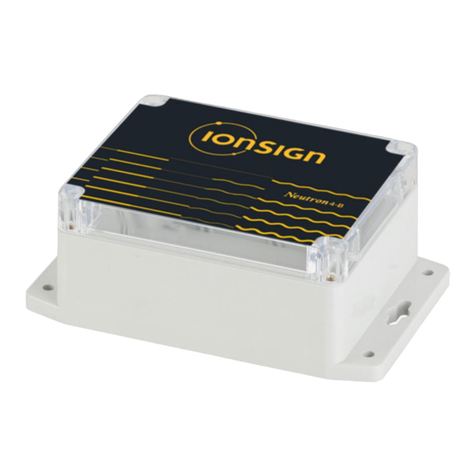
ionSign
ionSign Neutron4-B quick guide
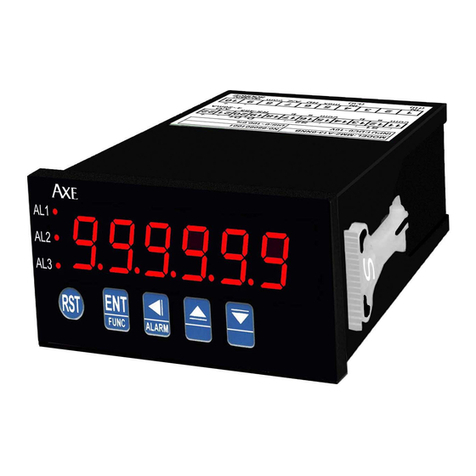
AXE
AXE MCHH Series Operation manual
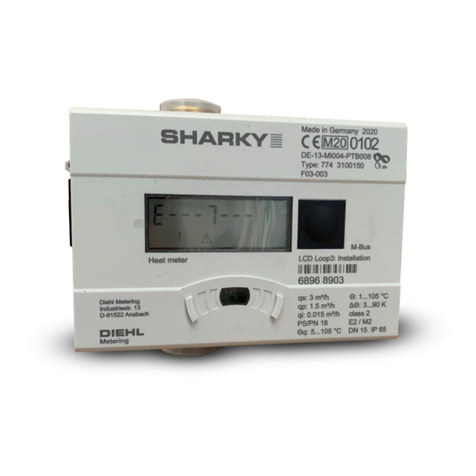
Diehl
Diehl SHARKY 774 Inspection and Test Instruction

WATANABE ELECTRIC INDUSTRY
WATANABE ELECTRIC INDUSTRY AP-301 Series instruction manual

Amprobe
Amprobe VP-600SB manual
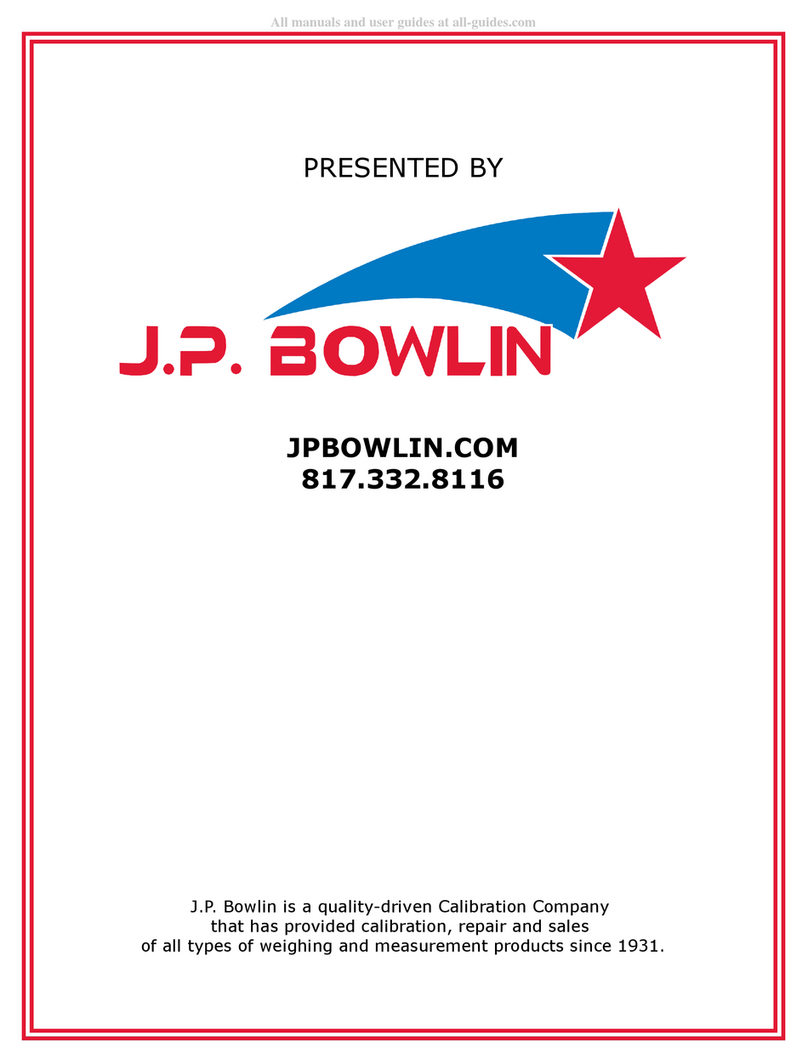
Minebea Intec
Minebea Intec Puro operating instructions
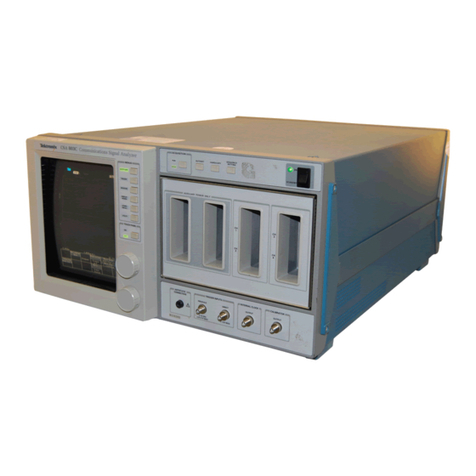
Tektronix
Tektronix CSA 803C Service manual
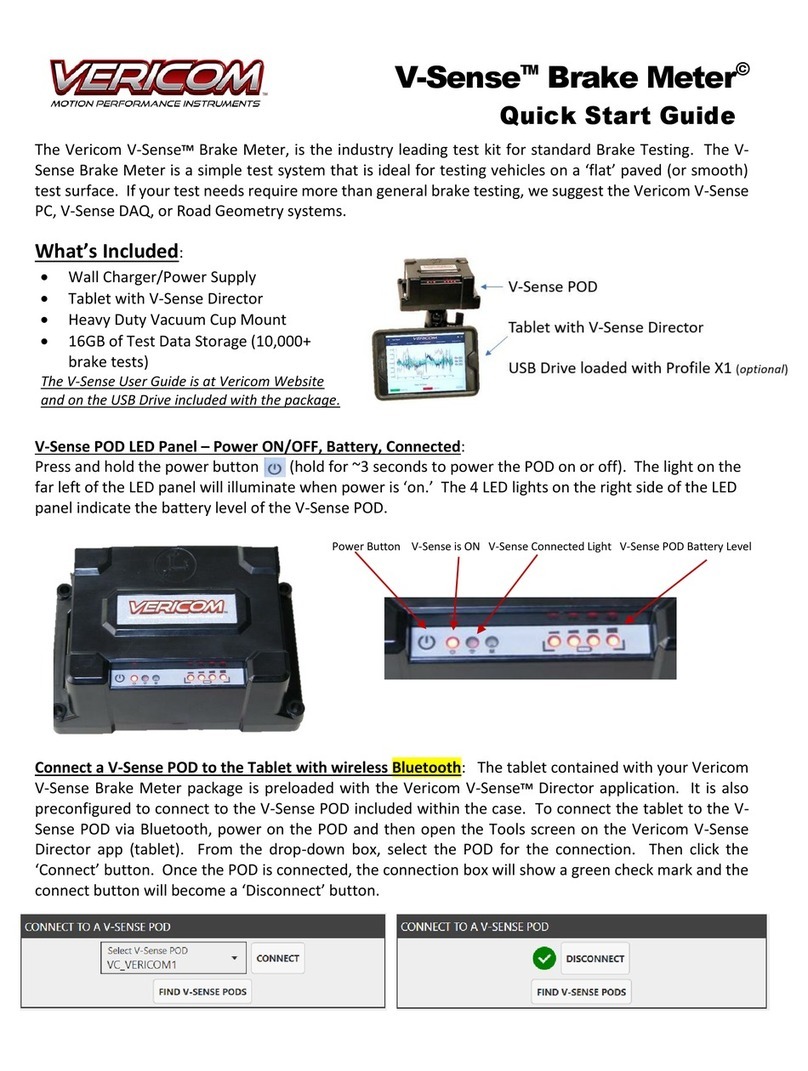
Vericom
Vericom V-Sense Brake Meter quick start guide
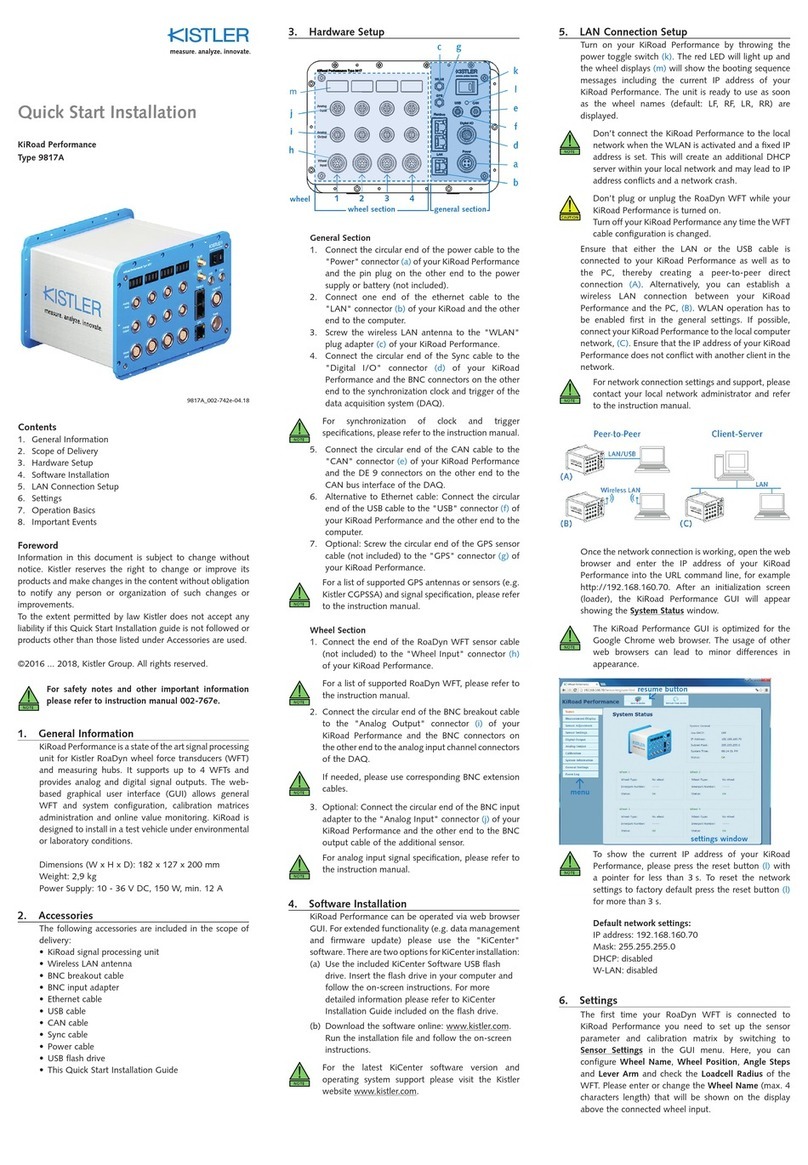
Kistler
Kistler KiRoad Performance 9817A Quick Start Installation

socomec
socomec DIRIS A40 operating instructions
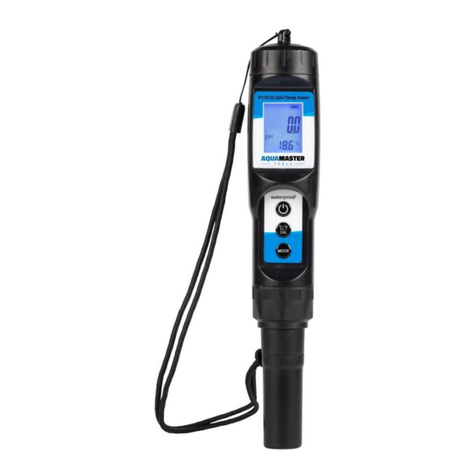
AquaMaster Tools
AquaMaster Tools Combo pen P110 Pro user manual
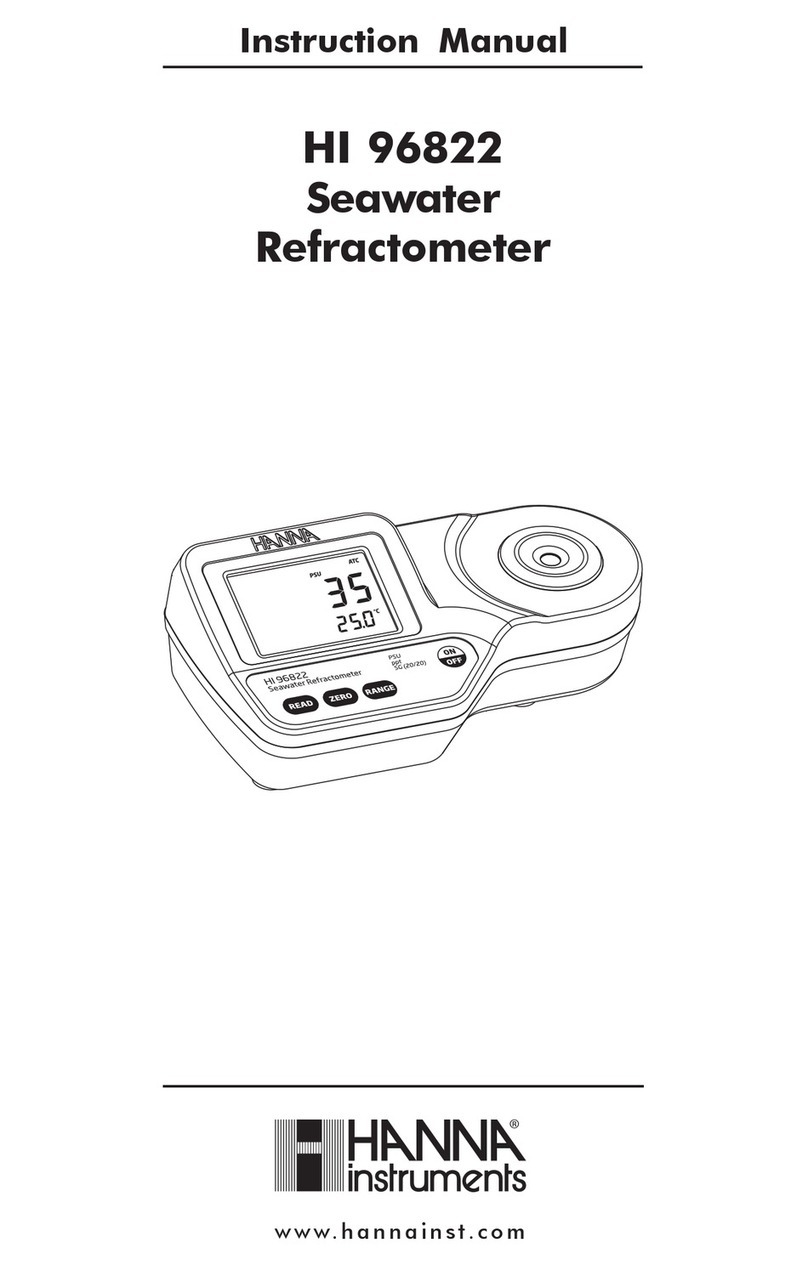
Hanna Instruments
Hanna Instruments HI 96822 instruction manual



